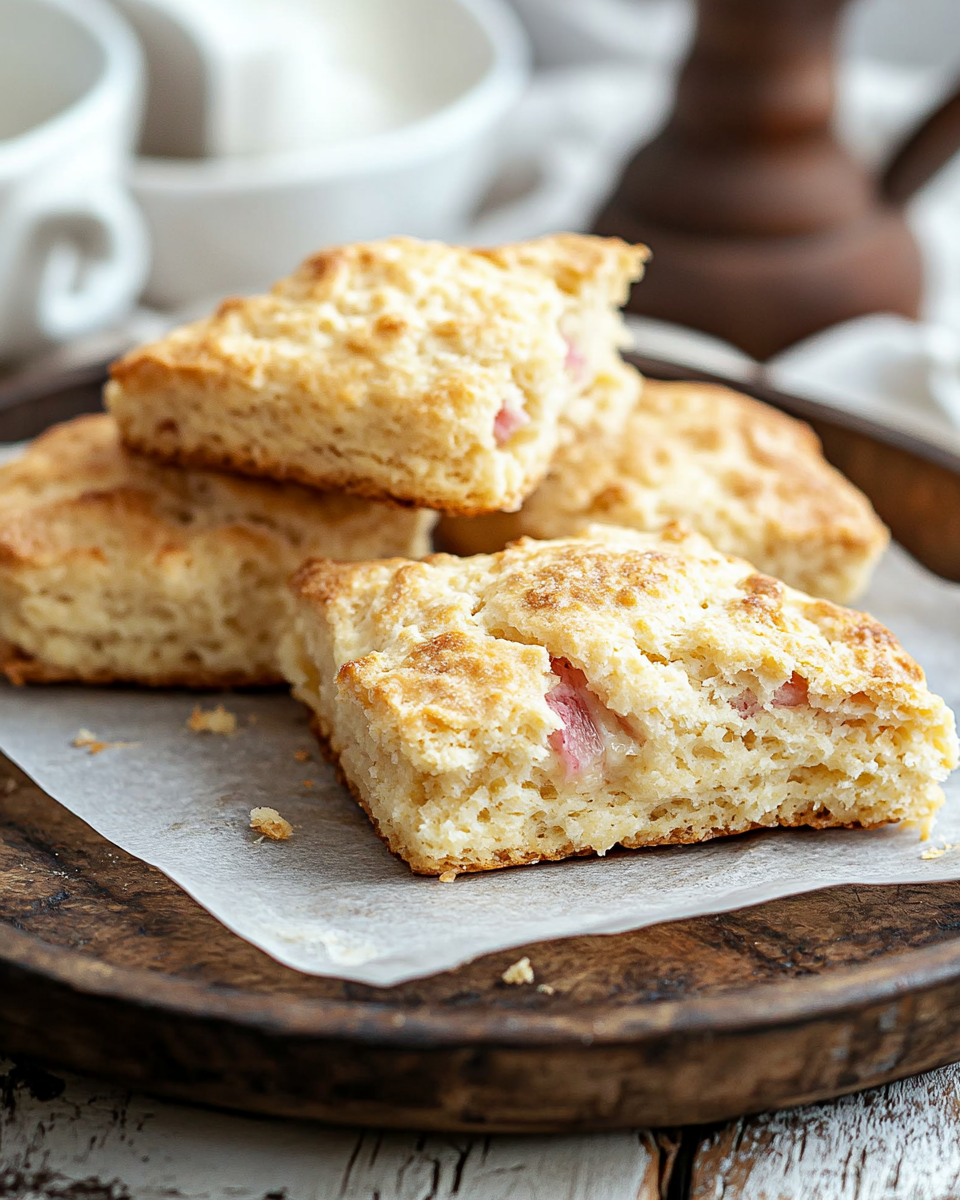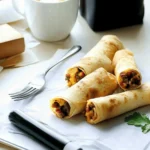These buttery rhubarb scones are a delightful treat combining flaky, tender pastry with the tart brightness of fresh rhubarb. Perfect for breakfast, brunch, or an afternoon snack, they capture the nostalgic flavors of grandma’s kitchen with a simple yet satisfying recipe.
FULL RECIPE
Ingredients
- 2 cups all-purpose flour
- 1/4 cup granulated sugar
- 1 tablespoon baking powder
- 1/2 teaspoon salt
- 1/2 cup cold unsalted butter, cut into small pieces
- 1 cup chopped fresh rhubarb
- 2/3 cup heavy cream, plus extra for brushing
- 1 large egg
- 1 teaspoon vanilla extract
- Optional: coarse sugar for sprinkling
Directions
- Preheat oven to 400°F (200°C). Line a baking sheet with parchment paper.
- In a large bowl, whisk together flour, sugar, baking powder, and salt.
- Cut in the cold butter using a pastry cutter or your fingers until mixture resembles coarse crumbs.
- Gently fold in the chopped rhubarb.
- In a separate bowl, whisk together cream, egg, and vanilla extract.
- Pour wet ingredients into dry ingredients and mix until just combined; do not overmix.
- Turn dough out onto a floured surface and gently knead a few times to bring it together.
- Pat dough into a 1-inch thick circle and cut into 8 wedges.
- Place scones on the baking sheet, brush tops with cream, and sprinkle with coarse sugar if desired.
- Bake for 18-22 minutes or until golden brown and a toothpick inserted comes out clean.
- Cool slightly before serving.
Nutritional Information
- Calories: 280 per scone
- Fat: 16g
- Carbohydrates: 30g
- Protein: 4g
- Fiber: 1g
- Sugar: 10g
History of Rhubarb Scones
Rhubarb has long been cherished in baking for its tart flavor that perfectly complements sweet pastries. The tradition of making scones with rhubarb dates back many generations, especially in regions where rhubarb grows abundantly during spring and early summer. These scones have become a nostalgic favorite, often passed down as a family recipe, symbolizing warmth and comfort.
The Role of Rhubarb in Baking
Rhubarb’s unique tartness adds a bright contrast to the rich, buttery nature of scones. When baked, rhubarb softens but retains enough texture to provide a pleasant bite. Its natural acidity balances the sweetness in the dough, preventing the scones from becoming overly sugary.
Choosing Fresh vs. Frozen Rhubarb
While fresh rhubarb is preferred for its vibrant flavor and texture, frozen rhubarb can be a convenient alternative when fresh stalks are out of season. However, frozen rhubarb tends to release more moisture during baking, which may affect the dough consistency slightly and requires gentle handling.
The Importance of Cold Butter
Cold butter is key in achieving the flaky texture that defines a perfect scone. When the cold butter melts during baking, it creates steam pockets that lift the dough. Using butter that is too soft will result in dense, crumbly scones rather than light and airy ones.
Flour Types and Their Effects
All-purpose flour is most commonly used for rhubarb scones because it provides a good balance of protein for structure and tenderness. However, experimenting with pastry flour can yield a softer, more delicate crumb, while whole wheat flour adds nuttiness and more fiber but can make the scones denser.
Sugar Variations in the Recipe
Granulated sugar provides sweetness and aids in browning. Some variations may include brown sugar or honey to introduce a deeper flavor profile. The sugar level can also be adjusted depending on the tartness of the rhubarb and personal preference.
The Role of Baking Powder
Baking powder is the leavening agent that helps scones rise and become fluffy. The right amount is essential; too little will produce flat scones, while too much can cause an unpleasant metallic taste.
Adding Vanilla Extract
Vanilla adds a subtle sweetness and aromatic warmth to the dough, enhancing the overall flavor without overpowering the rhubarb’s natural tartness. It’s a small addition that can make a significant difference in taste.
Incorporating Heavy Cream
Heavy cream contributes to the richness of the scones and helps bind the dough together. It also adds moisture, making the scones tender and moist while giving them a slight sheen when brushed on top before baking.
Cutting Techniques for Scones
Cutting the dough into even wedges ensures consistent baking. Using a sharp knife or a dough cutter helps maintain the dough’s integrity and prevents it from becoming too warm, which can affect texture.
Baking Temperature and Time
Baking at a high temperature, such as 400°F, helps the scones develop a golden crust while baking the inside thoroughly. The baking time must be carefully monitored to avoid drying them out or leaving the center undercooked.
Serving Suggestions
Buttery rhubarb scones are delicious served warm with clotted cream, butter, or jam. They also pair well with a cup of tea or coffee, making them an excellent choice for breakfast or afternoon tea.
Storing Rhubarb Scones
Scones are best enjoyed fresh but can be stored in an airtight container at room temperature for up to two days. To keep them moist, wrapping them in plastic wrap or reheating gently in the oven or microwave before serving is recommended.
Freezing and Reheating
These scones freeze well and can be stored for up to three months. When ready to eat, thaw them at room temperature and warm in the oven to restore their fresh-baked texture and flavor.
Health Benefits of Rhubarb
Rhubarb is low in calories and rich in vitamins, fiber, and antioxidants. While scones themselves are indulgent, the addition of rhubarb adds a nutritional boost and a refreshing tartness that can make treats feel a little lighter.
Potential Allergies and Substitutions
For those with dairy allergies, butter and cream can be substituted with plant-based alternatives, though texture may vary. Gluten-free flour blends can also replace all-purpose flour for gluten sensitivities, but care must be taken to adjust liquid ratios.
Cultural Significance
In many cultures, rhubarb marks the arrival of spring and early summer, celebrated in festivals and seasonal dishes. Scones like these often evoke feelings of tradition and community, enjoyed during family gatherings or festive brunches.
Pairing Rhubarb Scones with Beverages
Besides tea and coffee, rhubarb scones pair nicely with light wines such as sparkling rosé or a crisp white wine. Non-alcoholic options like lemonade or fruit-infused water complement their tart and buttery flavors as well.
Variations to Try
Many bakers experiment by adding spices such as cinnamon or ginger to the dough for extra warmth. Others mix in nuts or dried fruits for texture and sweetness contrasts, allowing endless customization while keeping the rhubarb as the star.
Advertisement
Tips for Perfect Scones Every Time
Keep ingredients cold, handle the dough minimally, and use fresh rhubarb for the best results. Preheating the oven and not overcrowding the baking sheet also ensures even cooking and beautiful golden edges.
Conclusion
Buttery rhubarb scones are a timeless baked good that combines rustic charm with bright, tangy flavors. Their balance of rich, flaky dough and tart fruit makes them a versatile treat suited for various occasions. Whether enjoyed fresh from the oven or warmed later, these scones bring comfort and nostalgia to the table, making them a beloved classic worth mastering.






